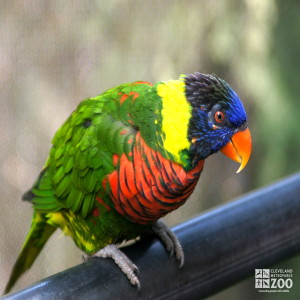Green-Naped Lorikeet
[Trichoglossus haematodus haematodus]

The green naped lorikeet has an overall length of about ten inches, and weight 3.5 to 5.5 ounces. The forehead, forecrown and chin are blue, and the ear-coverts and throat are purple-black. There is a greenish-yellow band on the nape. The lower throat and upper breast are bright red with purplish-black edges to the feathers, giving a barred appearance. The center of the abdomen is green, and the lower abdomen, flanks, thighs and under-tail coverts are yellow, with most of the feathers edged in green. The under-wing coverts and part of the flanks are red, and there is a broad yellow band across the underside of the flight feathers. The underside of the tail is olive, with the outer feathers having yellowish inner webs. The back, wings and upper side of the tail are green. The bill is orange-red and the iris is red. Immatures are duller than adults, with the bill brownish-black and the iris brown. The tongues of lorikeets are covered with brush-like papillae for mopping food from flowers, and the stomach is thin-walled for ready digestion.
Location: Lorikeet Aviary
Share:
Range
The range of the green naped lorikeet is Indonesia and New Guinea.
Habitat
Green naped lorikeets inhabit wooded country, rainforest, mangroves, riparian woodland, plantations, gardens, edges of vegetation
Conservation Status
Least ConcernPrimary Threats
Gestation
Eggs hatch in 25 to 27 days
Litter
Clutch: 1 to 3 eggs
Behavior
Green napes lorikeets tend to avoid dense primary forest. They are usually seen in pairs or in small flocks, but in certain flowering trees large numbers may congregate to feed. Like all lorikeets, they are arboreal and gregarious. Each morning at day-break they fly out from their roosts and disperse to feed, sometimes travelling 30 miles or more. They fly in compact groups, screeching regularly. At food trees they clamber agilely about the outer foliage, often hanging upside-down to rifle blossoms. During the heat of mid-day there is usually a lull in activity as they sit about preening each other. After another bout of intense feeding in late afternoon, they return to their roosts.
Reproduction
Pairing in green naped lorikeets is usually permanent. In courtship, male and female bow, bob and squirm close together, and sometimes roll over and over, playing at biting. Although the female appears to incubate alone, the male spends much time with her in the hollow, feeding her by regurgitation and roosting with her at night. The nest is usually a hollow limb or tree near water. The eggs are laid on wood dust at the bottom of the hollow. For several days after fledging, the young return to sleep in the nest. They fledge about eight weeks after hatching.
Wild Diet
Pollen, nectar, fruits, blossoms, seeds
Zoo Diet
Nectar, soft fruits, such as bananas, etc.
